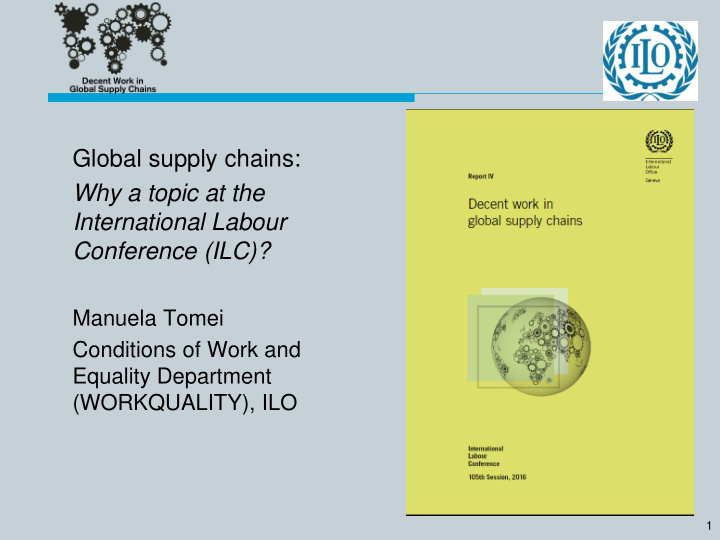



Global supply chains: Why a topic at the International Labour Conference (ILC)? Manuela Tomei Conditions of Work and Equality Department (WORKQUALITY), ILO 1
What are global supply chains? Organization of production and delivery of a range of goods and services by lead firms through complex chains of suppliers and sub- contractors that span many different countries. 2
Global supply chains range within 2 main types: 1. Foreign Direct Investment (FDI) by MNEs in wholly-owned subsidiaries or joint ventures 2. International sourcing: lead firms engage with a “cascade” of suppliers and sub-contracted firms with which they have no direct contractual relation, except for first-tier suppliers and/or intermediaries 3
FDI inflows by region 4
Global supply chains and employment Employment opportunities in developing countries incl. for women, youth and migrants Scale of employment in GSCs difficult to estimate but substantive and growing Quality of employment is a concern, esp. wages, OSH, working time and non- standard forms of employment (NSFE) 5
Why is ILO involved? C.177 on home-based work (1997); Social Justice Declaration (2008) Value-based approach to development Mandate and expertise in the world of work Tripartite structure Convening power to bring together main actors required to bridge governance gaps 6
Why is ILO involved? UNCTAD World Investment Report 2013 WTO Global Value Chains in a Changing World 2013 OECD, WTO and UNCTAD for G20 in 2013 Extensive research on global value chains and global supply chains BUT: first time quality of employment discussed at global level 7
Types of governance and related challenges Public governance Private governance Social partners’ initiatives Multilateral initiatives Challenges Regulatory space is crowded and confusing Lack of coherence and coordination Limits on extra-territorial application of legislation 8
Workers’ views Concerns about downwards pressure on conditions of work as a result of competition among suppliers Address global governance gap to ensure global floor of rights at work Tripartite constituents to become drivers of change to achieve decent work in GSCs Possible gaps in International Labour Standards and the MNE Declaration 9
Employers ’ views GSCs stimulate growth/decent work and are proven means of development Workers in GSCs enjoy better conditions than those outside GSCs. Pushing for DW for those already better off creates 2- tiered system International buyers and MNEs do not control/coordinate GSCs: suppliers are independent legal entities governed by national legislation Central problem is lack of enforcement of national legislation The primary duty to protect/enforce should not be shifted from States to companies 10
Governments’ views GSCs contribute to sustainable development and stimulate growth and employment DW challenges exist particularly in production/supplier countries Governance gaps at the national, sectoral, regional and global level: close through ILS, national legislation and enforcement Workplace compliance is primary duty State; GVTs often struggle with enforcement. Level playing field - avoid protectionism. Business responsibility: due diligence Inadequate national legislation concerning NSFE, informality, outsourcing, subcontracting and labour migration 11
Comprehensive ILO approach International labour standards Closing governance gaps Inclusive and effective social dialogue Cross-border social dialogue Capacity building and development cooperation Harmonizing processes and sector-level approaches Labour Administration & Inspection Knowledge and statistics Partnerships 12
Recommend
More recommend